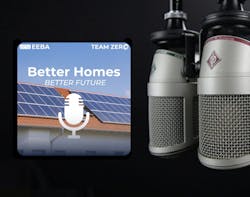Podcast: What is a high-performance home?
Do you know what makes a high-performance home? As the building industry continuously shifts and evolves, the standards for high-performance homes are also subject to change. That’s nothing to worry about, though. The Mitsubishi Electric Performance Construction team can help you stay up-to-date and ready to educate your customers on maximizing health, comfort, resilience and sustainability in high-performance homes.
Ken Johnson, senior manager of performance construction, Mitsubishi Electric Trane HVAC US (METUS) recently joined Rich Williams, vice president of Alliance Green Builders on an episode of the Better Homes, Better Future podcast, presented by Energy & Environmental Building Alliance’s (EEBA) Team Zero. During the one-hour recording, the duo spoke with Aaron Smith, EEBA CEO, to break down the basics of high-performance building and the importance of an efficient HVAC system as the “lungs and arteries” of a home. They also delve into today’s best practices, industry trends and their personal experiences living in purpose-built homes.
Speaking from Experience
Ken recently made several energy-efficient upgrades to his own 1,600-square-foot home. Built in 1938 in Long Beach, California, the single-level home had been renovated over the decades to include modern comfort technologies, but Ken knew he wanted to incorporate more sustainability into his home life. He started by purchasing an electric vehicle, and then he installed a new electric dryer and a photovoltaic system on his roof. Replacing his old, noisy gas furnace with an all-electric ducted air handler was a natural next step.
“We had an old gas furnace with a split system with a condenser that was right outside of our bedroom. It was loud, it was uncomfortable,” Ken explains. “I replaced the ducts and put in an air handler. We left the condenser right where it was, but now of course, that condenser is super quiet and I’ve noticed the difference in our house is pretty unbelievable in terms of comfort. When we set the temperature to, let’s say, 70 or 72° F, that’s where it stays.”
As an added bonus, the process was an educational experience for Ken. “I learned things about our system that, even though I’d been selling them for a few years, I didn’t know,” Ken explained.
Built Green, Built for Performance
It’s tough to deny the advantages of high-performance building. As Rich puts it, “One of the beauties about high-performance homes is that it’s great for the occupants and great for the environment at the same time.”
As the company’s name implies, Alliance Green Builders specializes in environmentally-conscious projects, creating healthy, sustainable and resilient homes in the greater San Diego area. His experience has taught him there isn’t a one-size-fits-all approach to high-performance building and he’s had to come up with a few tricks of the trade.
Rich explains, “In the construction that we do, not every home is trying to achieve Passive House certification, so we thought, let’s sneak our Passive House fundamentals into standard projects. We don’t get sets of plans for high-performance homes. We have to work our magic into that.”
Additional topics covered include:
- The criteria for high-performance homes
- The importance of comfort for homeowners
- How all-electric systems conserve energy, improve indoor air quality and save homeowners on utility bills
- All-electric vs. fossil fuel-burning appliances
To listen to the full episode of “What is a High-Performance Home?,” click here. For more information about all-electric heating and cooling systems from Mitsubishi Electric, visit MitsubishiComfort.com.
